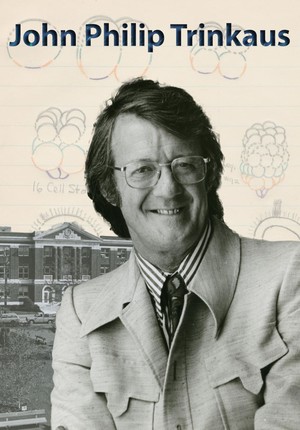Trinkaus was born on 23 May 1918 at his childhood home in Rockville Center, New York, to Franciska Magdalena Krüger and Charles Edward Trinkaus. In his autobiography, Trinkaus described his early childhood as one typical of “respectable, middle-class, white-collar, Protestant” families during those years (Trinkaus 2003, 3). His parents were both republicans and devout Methodists, as was Trinkaus until he became an atheist during his late teenage years. Trinkaus claimed that his proximity to the Atlantic Ocean as a child, along with its estuaries and salt marshes, provided many occasions to explore his natural surroundings and to swim and fish, contributing to his life-long interest in biology. Before he entered college at Wesleyan University in Middletown, Connecticut, Trinkaus attended public school, where he recalled fond memories of his first exposure to the study of natural history and biology, as well as his talent and love for drama.
- Atz, James W. "Fundulus heteroclitus in the laboratory: a history." American zoologist 26, no. 1 (1986): 111-120.
- Betchaku, Teiichi, and J. P. Trinkaus. “Programmed endocytosis during epiboly of Fundulus heteroclitus.” American zoologist 26, no. 1 (1986): 193-199.
- Davis, Edward M., and J. P. Trinkaus. "Significance of cell-to-cell contacts for the directional movement of neural crest cells within a hydrated collagen lattice." Journal of embryology and experimental morphology 63, no. 1 (1981): 29-51.
- DuPont, Ellen M. "John Philip Trinkaus (1918-2003)." Embryo Project Encyclopedia (2012).
- Goodrich, H. B., and J. P. Trinkaus. "The differential effect of radiations on mendelian phenotypes of the goldfish, Carassius auratus." The Biological Bulletin 77, no. 2 (1939): 192-199.
- Goodrich, H. B., and J. P. Trinkaus. "The differential effect of radiations on mendelian phenotypes of the goldfish, Carassius auratus." The Biological Bulletin 77, no. 2 (1939): 192-199.
- Goodrich, H. B., N. D. Josephson, J. P. Trinkaus, and Jeanne M. Slate. "The cellular expression and genetics of two new genes in Lebistes reticulatus." Genetics 29, no. 6 (1944): 584-592.
- Keller, Ray, Wallis H. Clark, and Frederick Griffin (Eds.) Gastrulation: Movements, Patterns, and Molecules. New York: Plenum Press, 1991.
- Kimmel, Charles B., and James A. Weston. "An overview of Trink's scientific accomplishments." Developmental Dynamics 228, no. 4 (2003): 586-587.
- Saunders, John W. "Trink, the man." Developmental Dynamics 228, no. 4 (2003): 588-590
- Schoenwolf, Gary C. "Trink: His life, his philosophy." Developmental Dynamics 228, no. 4 (2003): 591-593.
- Tickle, Cheryll A., and J. P. Trinkaus. "Change in surface extensibility of Fundulus deep cells during early development." Journal of cell science 13, no. 3 (1973): 721-726.
- Tickle, Cheryll A, and J. P. Trinkaus. "Observations on nudging cells in culture." Nature 261, no. 5559 (1976): 413-413.
- Trinkaus, J. Philip. "Factors concerned in the response of melanoblasts to estrogen in the Brown Leghorn fowl." Journal of Experimental Zoology 109, no. 1 (1948): 135-169.
- Trinkaus, John Philip. "The surface gel layer of Fundulus eggs in relation to epiboly." Proceedings of the National Academy of Sciences of the United States of America 35, no. 4 (1949): 218.
- Trinkaus, John Philip. "A study of the mechanism of epiboly in the egg of Fundulus heteroclitus." Journal of Experimental Zoology 118, no. 2 (1951): 269-319.
- Trinkaus, John Philip. "The differentiation of tissue cells." American Naturalist (1956): 273-289.
- Trinkaus, John Philip. “Procurement, maintenance and use of Fundulus eggs,” Methods in Developmental Biology. F.H. Wells and N.K. Wessells (Eds.) Crowell, New York: 1967, 113-122.
- Trinkaus, J. P. "The cellular basis of Fundulus epiboly. Adhesivity of blastula and gastrula cells in culture." Developmental biology 7 (1963): 513-532.
- Trinkaus, J. P. "Surface activity and locomotion of Fundulus deep cells during blastula and gastrula stages." Developmental biology 30, no. 1 (1973): 68-103.
- Trinkaus, J. P. "Mechanism of Fundulus epiboly—a current view." America n Zoologist 24, no. 3 (1984): 673-688.
- Trinkaus, John Philip. Cells into organs: the forces that shape the embryo. (2nd Ed.) New Jersey: Prentice-Hall, Inc., 1984.
- Trinkaus, John Philip. “Directional cell movement during early development of the teleost Blennius Pholis. I. Formation of epithelial cell clusters and their pattern and mechanism of movement.” Journal of Experimental Zoology 245 (1988a): 157-186.
- Trinkaus, John Philip. “Directional cell movement during early development of the teleost Blennius Pholis. II. Transformation of the cells of epithelial clusters into dendritic melanocytes, their dissociation from each other, and their migration to and invasion of the pectoral fin buds.” Journal of Experimental Zoology 248 (1988b): 55-72.
- Trinkaus, John Philip. Embryologist: My Eight Decades in Developmental Biology. J&S Publishing Company, 2003

